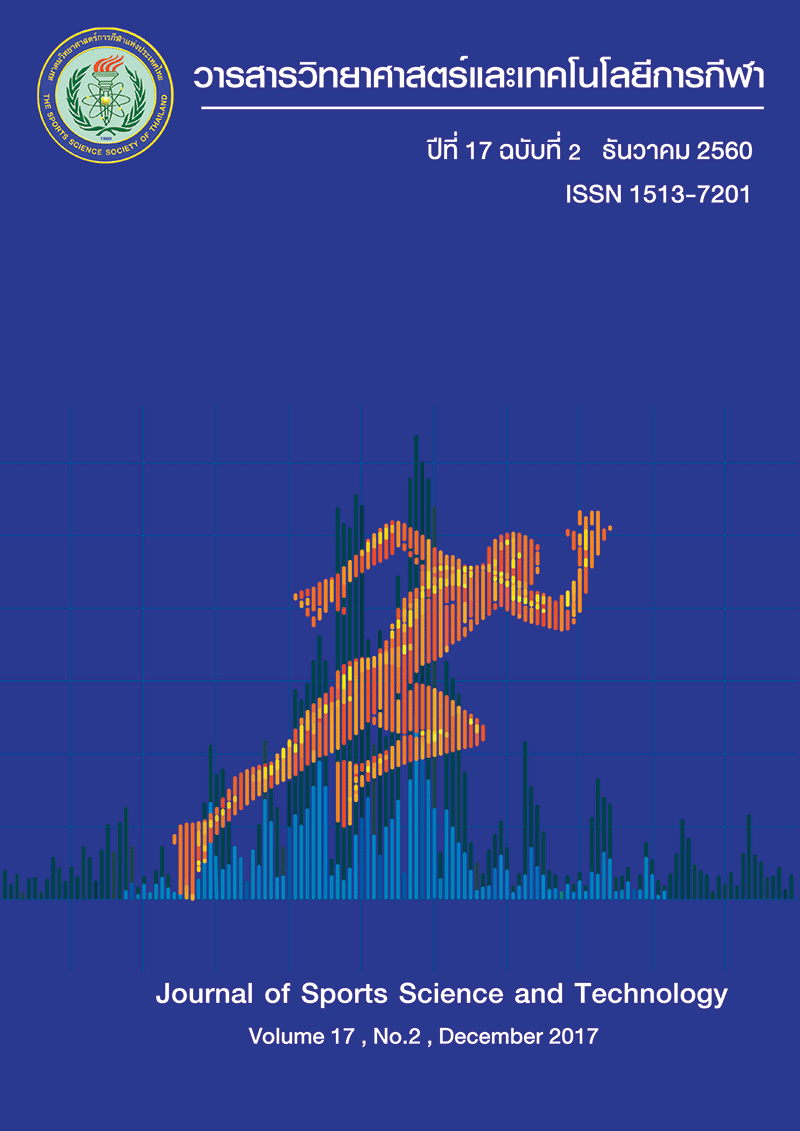LANDING ERROR SCORING SYSTEM FOR SCREENING RISK SCORES BETWEEN MALE AND FEMALE IN UNIVERSITY STUDENTS
Keywords:
Landing Error / Screening Tool / Injury RiskAbstract
Background: The lower extremity is the location of the highest injury incidence rate in sporting injuries and there may be a difference in the type of injury sustained between genders. The injuries affect loss of playing time and are in some cases expensive to treat, or rehabilitate. Therefore, screening for risk factors is an important consideration in injury prevention. Purpose: The purpose of this study was to compare the scores of the Landing Error Scoring System test (LESS) between male and female University students. Method: Thirteen males (age; 19.5 ± 0.7 years, body weight; 59.5 ± 2.9 kg, height; 166.6 ± 2.9 cm) and fourteen females (age; 19.5 ± 0.8 years, body weight; 58.8 ± 3.8 kg, height; 166.1 ± 3.2 cm) participants completed the LESS. Data were recorded using two video cameras (300 frame per sec) in both sagittal and frontal planes, the subjects practice 2 trials and subjects show their performance of 3 successful trials of the jump-landing task. Then, motion analysis used 2 plane video recorded analysis by LESS score sheet and statistical analyzed using either an independent sample t-test to compare the differences in test scores between genders. The α was set at p < 0.05. Results: The LESS score was significantly lower in males compared with females (Males; 4.81 ± 1.52, Females; 6.11 ± 1.73, respectively; p = 0.050). The four level of LESS score no significant difference, the excellent (3.05 ± 0.41, 3.30 ± 0.42), the good level (4.60 ± 0.28, 4.65 ± 0.49), the moderate level (5.86 ± 0.23, 6.00 ± 0.00) and the poor level (7.15 ± 0.21, 7.38 ± 1.80), males and females respectively. Conclusion: The LESS test scores suggest females have a greater likelihood of lower extremity injury risk compared with males.
(Journal of Sports Science and Technology 2017; 17(2):19- 30)
Keywords: Landing Error / Screening Tool / Injury Risk
*Corresponding author: Kornkit CHAIJENKIJ
College of Sports Science and Technology,
Mahidol University, Nakhon Pathom, Thailand 73170
E-mail:kornortho@gmail.com
References
2. Murphy DF, Connolly DA, Beynnon BD. Risk factors for lower extremity injury: a review of the literature. British Journal of Sports Medicine. 2003; 37(1): 13-29.
3. Beynnon BD, Vacek PM, Newell MK, Tourville TW, Smith HC, Shultz SJ, et al. The Effects of Level of Competition, Sport, and Sex on the Incidence of First-Time Noncontact Anterior Cruciate Ligament Injury. The American Journal of Sports Medicine. 2014; 42(8): 1806-12.
4. Padua DA, Marshall SW, Boling MC, Thigpen CA, Garrett WE, Jr., Beutler AI. The Landing Error Scoring System (LESS) Is a valid and reliable clinical assessment tool of jump-landing biomechanics: The JUMP-ACL study. The American Journal of Sports Medicine. 2009; 37(10): 1996-2002.
5. Padua DA, Boling MC, Distefano LJ, Onate JA, Beutler AI, Marshall SW. Reliability of the landing error scoring system-real time, a clinical assessment tool of jump-landing biomechanics. Journal of Sport Rehabilitation. 2011; 20(2): 145-56.
6. Weiss L, DeForest B, Hammond K, Schilling B, Ferreira L. Reliability of goniometry-based Q-angle. PM & R: The journal of Injury, Function, and Rehabilitation. 2013; 5(9): 763-8.
7. Robert A Malinzak, Scott M Colby, et al. A comparison of knee joint motion patterns between men and women in selected athletic tasks. Clinical Biomechanics. 2001; 16(5): 438-445.
8. Beutler A, de la Motte S, Marshall S, Padua D, Boden B. Muscle strength and qualitative Jump-Landing differences in male and female military cadets: The jump-ACL study. Journal of Sports Science & Medicine. 2009; 8: 663-71.
9. Nikolaidis PT. Body mass index and body fat percentage are associated with decreased physical fitness in adolescent and adult female volleyball players. Journal of Research in Medical Sciences: The Official Journal of Isfahan University of Medical Sciences. 2013; 18(1): 22-6.
10. Theiss JL, Gerber JP, Cameron KL, Beutler AI, Marshall SW, Distefano LJ, et al. Jump-landing differences between varsity, club, and intramural athletes: the Jump-ACL Study. Journal of Strength and Conditioning Research. 2014; 28(4): 1164-71.
30
วารสารวิทยาศาสตร์และเทคโนโลยีการกีฬา ปีที่ 17 ฉบับที่ 2, ธันวาคม 2560
Journal of Sports Science and Technology Volume 17, No. 2, December 2017
11. Wesley CA, Aronson PA, Docherty CL. Lower Extremity Landing Biomechanics in Both Sexes After a Functional Exercise Protocol. Journal of Athletic Training. 2015; 50(9): 914-20.
12. Lam KC, Valovich McLeod TC. The impact of sex and knee injury history on jump-landing patterns in collegiate athletes: a clinical evaluation. Clinical Journal of Sport Medicine: Official Journal of The Canadian Academy of Sport Medicine. 2014; 24(5): 373-9.
13. Oller DM, Buckley WE, Sebastianelli WJ, Vairo GL. Injury and illness epidemiology at a summer sport-camp program, 2008 through 2011. Journal of Athletic Training. 2015; 50(3): 313-20.
14. Alentorn-Geli E, Myer GD, Silvers HJ, Samitier G, Romero D, Lazaro-Haro C, et al. Prevention of non-contact anterior cruciate ligament injuries in soccer players. Part 1: Mechanisms of injury and underlying risk factors. Knee surgery, sports traumatology, arthroscopy: Official Journal of The ESSKA. 2009; 17(7): 705-29.
15. Myer GD, Ford KR, Palumbo JP, Hewett TE. Neuromuscular training improves performance and lower-extremity biomechanics in female athletes. Journal of Strength and Conditioning Research. 2005; 19(1): 51-60.
16. Withrow TJ, Huston LJ, Wojtys EM, Ashton-Miller JA. Effect of varying hamstring tension on anterior cruciate ligament strain during in vitro impulsive knee flexion and compression loading. The Journal of Bone and Joint Surgery American Volume. 2008; 90(4): 815-23.
17. Gokeler A, Eppinga P, Dijkstra PU, Welling W, Padua DA, Otten E, et al. Effect of fatigue on landing performance assessed with the landing error scoring system (less) in patients after ACL reconstruction. A pilot study. International Journal of Sports Physical Therapy. 2014; 9(3): 302-11.






